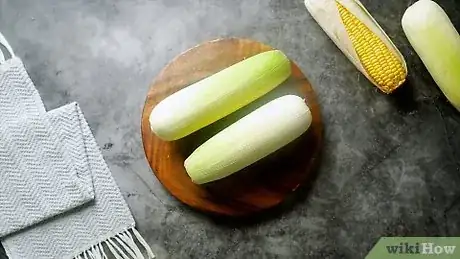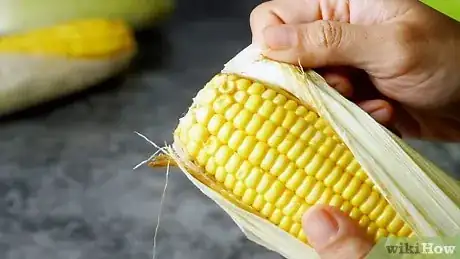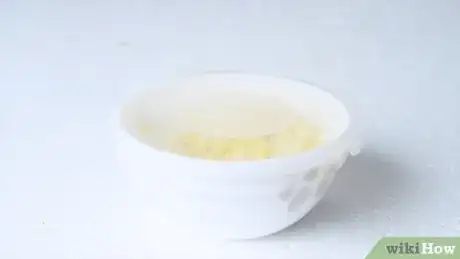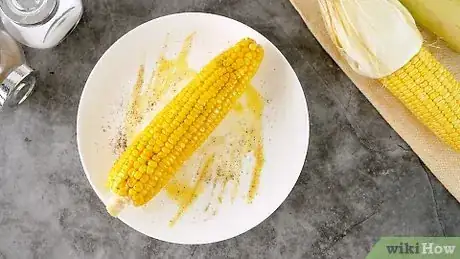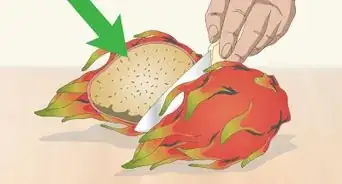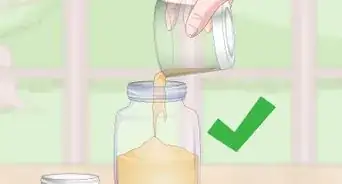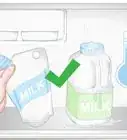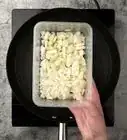This article was co-authored by wikiHow Staff. Our trained team of editors and researchers validate articles for accuracy and comprehensiveness. wikiHow's Content Management Team carefully monitors the work from our editorial staff to ensure that each article is backed by trusted research and meets our high quality standards.
The wikiHow Culinary Team also followed the article's instructions and verified that they work.
This article has been viewed 157,377 times.
Learn more...
Corn on the cob is one of summer's tastiest, freshest treats, so of course, you want to figure out how to keep it fresh after buying it. You can store the whole cobs (including husks) in the fridge until you cook it. You can also store (husked) corn in the freezer after blanching it to prolong its life. In addition, make sure you store corn in the refrigerator after it's cooked.
Steps
Storing Fresh Corn on the Cob
-
1Leave the husks on. The husks help keep the corn moist and fresh. If you peel the husks before storing, you run the risk of the corn drying out. Try to not even peel the tips of the husks back.[1]
- Use your corn in a day or two if you've already removed the husks.
- To buy corn without peeling the husks back, start by looking for corn that has green husks and moist corn silk sticking out. The cob should feel firm all the way from top to bottom. Check for tiny holes, which indicate the corn has worms. If you must peel the husk, only do a little bit at the top to see if the kernels go all the way to the end.[2]
-
2Place them in a sealed plastic bag. Do not wash the corn first. Place them in a large zip-top bag, and seal it up with as little air as possible. Set the bag in the vegetable drawer of your refrigerator.[3]Advertisement
-
3
-
4Check for freshness. Corn will start to mold at the tip first. If you see a dark or moldy end, you can cut off the end plus 1 inch (2.5 cm). However, if the whole cob looks moldy, you should throw it out instead of eating it.[6]
- Moldy corn typically turns dark and the kernels shrivel. You may also see fuzzy growth on the corn that is white or blue.
Freezing Fresh Corn on the Cob
-
1
-
2Blanch and freeze whole ears to keep the corn on the cob. To blanch whole ears, place them boil in water for 7 to 11 minutes, depending on the size of the ears. Pull them out of the water and plunge them in ice water immediately for about 30 seconds or so. Drain the extra water off.[8]
- Place the corn in freezer bags or airtight containers and freeze. If using a bag, squeeze out as much air as you can before zipping it shut.
- You can cook them for less time if you prefer. Cooking them for less time makes for crunchier corn when you pull them out of the freezer.
-
3Blanch and freeze kernels for an easier defrosting process. Blanch the whole ears in boiling water. Plunge them into boiling water for 2 1/2 minutes. You can cook them a bit longer if you prefer. Pull them out, and plunge them into ice water. Drain the excess water off.[9]
- Use a knife to slice off the kernels. Place the kernels in freezer bags or airtight containers to freeze. Squeeze out excess air when using bags.
-
4Freeze the kernels without blanching to make freezer preparation faster. Another option is to freeze just the kernels. Slice off the kernels from the cob. Place the kernels in freezer bags or airtight containers before placing them in the freezer. Get out as much air as possible when using freezer bags.[10]
-
5Defrost the corn before warming it or zap it in the microwave to cook it. You can defrost blanched corn in the refrigerator overnight and warm it up for eating the next day. You can also simply zap both blanched and raw corn in the microwave until it's warm enough to eat.
- Use the defrost setting on your microwave. Enter the pounds in weight for your corn. If you're not sure of the weight, check the corn after 2 minutes.
Storing Cooked Corn on the Cob
-
1Place whole ears in an airtight container. It's best to store any leftover cooked corn in an airtight container. You can also stick it in a zip-top bag if you'd like. Keeping the air out of the corn will keep it fresher, so squeeze as much air out of the zip-top bag as you can.[11]
-
2Cut the kernels off the cob if you prefer. If you want to use the leftovers in another dish, you can cut the kernels off the cob. Once you've sliced them off, stick them in an airtight container before setting the container in the fridge. You can also use a zip-top bag with the air squeezed out.[12]
-
3Eat in 3 to 5 days. Once the corn on the cob has been cooked, you've extended its life by a few days. Once you cook it, you have an additional 3 to 5 days to eat past the original expiration date. Still, you should aim to eat it in 5 days at most when you keep it in the refrigerator.[13]
- If the corn has a funny odor or it has grown mold, it's time to toss it.
- You can reheat corn in the microwave. Start with a minute, and then check to see if it needs more time.
Community Q&A
-
QuestionCan I take the corn fresh from the garden and put in the freezer whole without blanching?
 Community AnswerYes, you can. We harvest them from the garden, husk and clean, then put in freezer bags and freeze. When we want to eat them, we boil them. They are super good this way and do not dry out. I suggest using vacuum-seal bags, as this prevents freezer burn.
Community AnswerYes, you can. We harvest them from the garden, husk and clean, then put in freezer bags and freeze. When we want to eat them, we boil them. They are super good this way and do not dry out. I suggest using vacuum-seal bags, as this prevents freezer burn. -
QuestionHow do I store corn that has been shucked?
 Community AnswerThe best option for storing shucked corn is freezing! You can blanch the corn if you want, but it isn't necessary. Also, taking the corn off the cob, then freezing works great without blanching. Either way, place the corn in a Ziploc bag, and remove as much air as you possibly can (a straw works great for removing air), and toss it in the freezer. When I freeze corn off the cob, I like to freeze it on a sheet pan covered with parchment paper. Place the corn in a single layer and freeze until hard, then toss it in the freezer. When you're ready to use the corn, you can take out just the amount you need, while the rest stays frozen.
Community AnswerThe best option for storing shucked corn is freezing! You can blanch the corn if you want, but it isn't necessary. Also, taking the corn off the cob, then freezing works great without blanching. Either way, place the corn in a Ziploc bag, and remove as much air as you possibly can (a straw works great for removing air), and toss it in the freezer. When I freeze corn off the cob, I like to freeze it on a sheet pan covered with parchment paper. Place the corn in a single layer and freeze until hard, then toss it in the freezer. When you're ready to use the corn, you can take out just the amount you need, while the rest stays frozen.
References
- ↑ http://www.stilltasty.com/fooditems/index/16964
- ↑ https://www.epicurious.com/ingredients/how-to-buy-and-store-corn-on-the-cob-article
- ↑ https://www.epicurious.com/ingredients/how-to-buy-and-store-corn-on-the-cob-article
- ↑ https://www.eatbydate.com/vegetables/fresh-vegetables/corn/
- ↑ https://www.epicurious.com/ingredients/how-to-buy-and-store-corn-on-the-cob-article
- ↑ https://www.eatbydate.com/vegetables/fresh-vegetables/corn/
- ↑ http://www.stilltasty.com/fooditems/index/16964
- ↑ http://www.stilltasty.com/fooditems/index/16964
- ↑ https://www.epicurious.com/ingredients/how-to-buy-and-store-corn-on-the-cob-article
About This Article
To store mint in a plastic bag, pat the mint with a paper towel to remove any excess moisture that could cause it to go bad. Then, dampen a paper towel with a small amount of water, and loosely wrap the mint in the paper towel. Slide the mint into a bag, being careful not to crush any of the leaves. Seal the bag without removing the air. Once the mint is in the bag, lay the bag flat on its side on a shelf in the refrigerator. You can keep the mint refrigerated for up to a week before the leaves will begin to darken and go bad.
